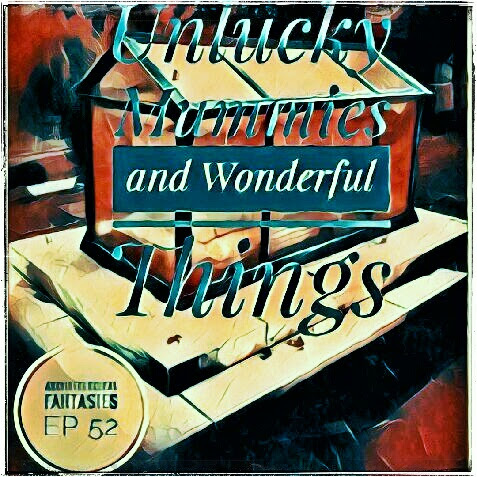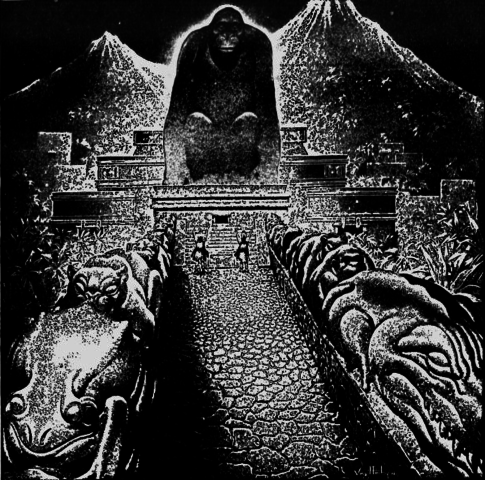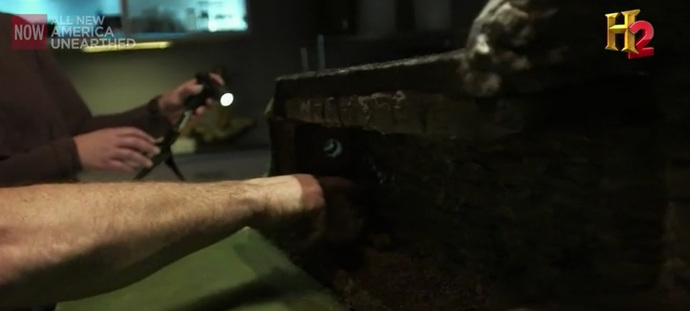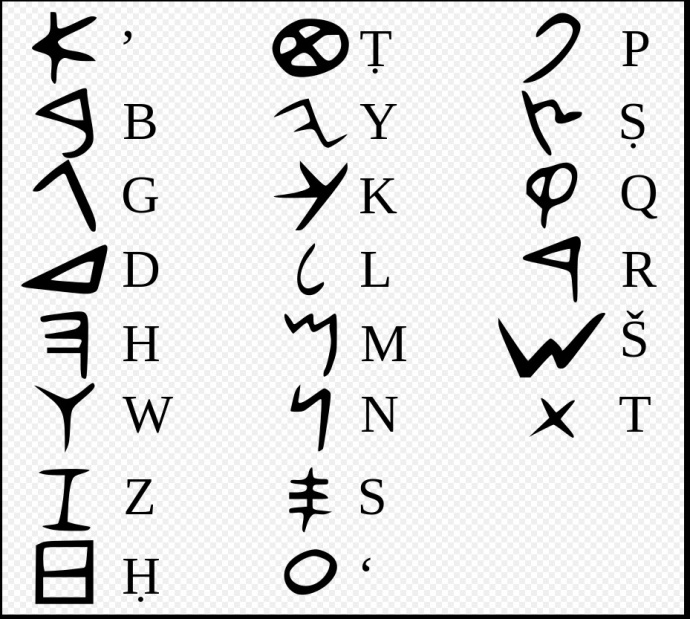
Yay! We’re about half way through the first season! I grossly underestimated how long it would take to review this series. There is just so much that needs to be addressed in each episode, it’s daunting. I am learning to break-up the posts into smaller posts that I can then link you too for more information. It’s still a lot of research and reviewing though, but I think it’s worth it.
As usual if you don’t want to read through the whole break down, feel free to skip to the In Summary section at the bottom, but as always, if you have a comment or question, witch I do welcome, don’t be surprised if I tell you to read the whole post first.

We open this episode with a sepia toned film of a man getting his hair cut while listing to the old-timmey radio. An announcer is telling us, H.G.Wells style, about a mysterious collection of stone structures that has been discovered. We then see haircut man walking though the woods and stopping, awestruck, when he finds several piles of stone.
Wolter does a voice over here talking about Stonehenge, calming that it’s origins and meaning are still shrouded in mystery. This is not true in the way Wolter means it, but hey, we have to set a tone right?
Wolter goes on:
“Some advanced civilization that knew enough about the sun moon and stars to align theses stones in a very specific way.”
Yah, it’s called every ancient civilization ever, Wolter, seriously.
He then goes on to make the extraordinary claim of the the show, that there is a Stonehenge in America and that this henge and actual Stonehenge were built by the same people.
We start in Salem, New Hampshire at a place now called American Stonehenge, but what was once called Mystery Hill. We meet Kenlsey Stone, son of the owner, who meets us at what is the central observatory of area. It’s a large covered gazebo. (Your +25 sword of BS slaying has no effect on it, and it’s not on fire.) There are small ‘standing stones’ that are arranged around the central point. It’s apparent from a casual glance that these stones were placed in a deliberate pattern and probably line up with something, probably solstices, equinoxes, and cross quarter days.

Wolter correctly points out here that many ancient cultures all over the world made note of these points of the year. He then ruins it by throwing up a simplistic definition of archaeoastronomy. He tells us that he saw archaeoastronomy in Georgia and that somehow connected Native Americans to the Mayans. (spoiler: he didn’t and it doesn’t)
He then makes another claim that caught my attention:
“The ancient practice of archaeoastronomy seems to tie many advanced cultures together.”…”and it also seems to tie them to America”
Couple of things her.
- Archaeoastronomy is a very common practice in most, if not all, prehistoric, ancient, and some modern cultures. It’s not a definitive sign of advance vrs not-advanced cultures. It was a tool necessary for everyday life, especially among agricultural societies. It was practiced in large scale, as seen in Stonehenge and the like, as well as on a small scale. My point here is it’s not a mystical magical unifying secret that only elite cultures were capable of understanding. It was part of basic everyday life, and was common because anyone can keep an eye on the sky and see that things change up there according to the seasons. It’s pretty much common sense.
- I think Wolter just made the claim that the diffusionism of archaeoastronomy came out of America. I may just be confused here, but if that is true, this is a major deviation from his normal claims that everything was brought to America by white people.
Now we’re focusing on one stone in particular, and we get to watch Wolter rubbing it as epic music swells in the background. Wolter asks Stone what happens in the circle and Stone tells us that the sun rises in the middle of the stone, but that they think it might have risen at the top point of the stone at some point in the past. Wolter agrees and there is a fancy computer generated model to show us where the sun might have been in 1800BC. We’re not immediately told why this date is important, but hey, we’re building anticipation here!

Wolter tells us that things can move the axis of the earth, like earthquakes, (or just the natural wobble of the planet), and we can use that for dating purposes. He then makes the claim that archaeoastronomy is more accurate for dating than C14 dating. This argument is, weird, and important for the story Wolter is trying to tell here and I’ll get to that in a minute.
Wolter tells us that the stones in the circle look weathered, which really means nothing. Any stone exposed to the elements will be weathered and Wotler has admitted as much in previous episodes of the show. I’m guessing he’s just talking out loud here.
Before we move on to how this henge is connected to Stonehenge, let’s recap a little here.
- We are being grossly misled here by not being given the full story of Mystery Hill and Americans Stonehenge. I cover it detail in my blog post here, but to briefly recap:
- The area known as Mystery Hill was once owned by Jonathan Pattee in 1837 (Gilbert 1907) and always had a bunch of natural caves and rock outcroppings. Pattee also built tons of structures on the land himself and these were commented on historically (Gilbert 1907, Starbuck 2006).
- The land passed into the hands of William Goodwin in 1937 who dubbed the area Mystery Hill (Wright 1998, Starbuck 2006, Crystalinks N.d.). He then began to move and quarry the rocks and structures already on the land in order to “restore” what he thought was Irish monastery (Starbuck 2006, Crystalinks N.d.) completely destroying the context of the area.
- Robert Stone bought the land in 1967 and the Stones have made a few improvements of their own (Starbuck 2006, Crystalinks N.d.). Adding a museum and changing the name to “America’s Stonehenge” trying to link the area to Stonehenge in England (Starbuck 2006).
- Several archaeological digs have been done in the area. Of them, the one led by Gary Vescelius in 1955 recovered over 7000 artifacts, all of which were Native American or 18th and 19th century in origin (Starbuck 2006, Crystalinks N.d.).
- What all this means is that American Stonehenge is completely out of context and even if it had been an actual ancient site, there is no way to ever know this due to the activities of Goodwin et al. Also, nothing has ever been found to suggest the area was ever settled by Ancient -Europeans.
- Wolter makes a claim that archaeoastronomy is a more accurate way to date a site than C14 dating. He’s not entirely wrong, in some situations this can be correct. However, the reasons he’s making this claim isn’t because of these unique situations.
- Mystery Hill has been excavated several times in the past, and one of the most recent excavations sent off charcoal samples to an actual lab to be c14 dated. The dates that came back do not support Wolter’s claims that the site dates back to 3800 ya. or 1800 BC.
- Wolter is also neglecting to mention that you can make the sun line up with pretty much any single object if you just move around it till the sun lines up. You can probably witness something in your back yard (if you have one) lining up with the sun rise/set by chance. Or you can do what was probably done here, and deliberately put something there (see my note above about Goodwin et al).
- Wolter’s computer generated model, though cool to look at, would only be valid if there wasn’t evidence that the stone he was using was probably moved and set up there intentionally by Goodwin et al.
- Wolter appears to be trying to obfuscate the actual facts here in order to manufacture a mystery where there is none. Which is the show’s M.O., it’s just way more pronounced here this time.
But, we’re not done here yet.
After Wolter get’s done rubbing all the stones and making weird claims about archaeoastronomy, Stone tells us that he’s got more to show us. Stone claims that this evidence will tie America’s Stonehenge to the actual Stonehenge. Of course Wotler wants to see it!
What is this amazing evidence you ask?
Lines on a map.
Stone takes us to his computer and pulls up Google Earth, and then proceeds to draw a line between to points. What two points? Why, Americas Stonehenge and actual Stonehenge! Amazing!
Unless you remember your basic math and graphing skills here and remember that you can draw a straight line between any two arbitrary points.
To add to the drama of this magical line, Stone proceeds to show us that the line continues (as all lines do) and then “ends” in Beirut. Why does it end here? Because why not? There is no explanation as to why our arbitrary line between two arbitrary points must end in Beirut, it just does. That’s good enough for Wolter who immediately begins making up a connection for it. It has something to do with Phoenicians around 1200 bc, and the math is all bad, but whatever! We have our connection!
At this point we get to meet Dennis Stone, father of Kenlsey Stone, and we get a very brief and sterilized history of Mystery Hill. We’re told about Johnathan Pattee and how the area used to be called Pattee’s Caves back in 1907. We’re even taken to what is possibly Pattee’s old house and Wolter makes his proclamation that Pattee couldn’t have made any of the structures on the site because:
“There’s no way Pattee could have built this, it just wreaks of being really old”
Very scientific of you Wolter.
Wolter tells us that if it’s old, it’s important. Not important enough to actually research, but hey, we’re busy building a mystery here. Wolter also dismisses Pettee’s ability to have built structures on his own land despite evidence that he in-fact did:
“He built massive stones walls when he had all these trees and he could have used wood? I don’t buy that”
Yes, it’s much more believable that Ancient Phoenician-European-Irish Monks came to New Hampshire in 1800 BC to build a monastery in the middle of nowhere so they could recreate Stonehenge and worship Baal. Oh wait, we haven’t gotten there yet.
So now Wotler is telling us that large flat rocks are like clocks and indicate the age of a structure. He doesn’t tell us how this works, but it apparently confirms something of his story. Stone tells us that there’s more on site to connect it to the Phoenicians and we’re introduced to the Baal Stone.

The stone, with it’s random scratching, was supposedly translated by Barry Fell back in the 1970’s and apparently is a dedication to the god Baal. Wolter makes a big production out of examining the stone, and eventually decides that the stone is old.
Personally, anything translated by Barry Fell is immediately invalid. Also the writing doesn’t look anything like the Phoenician alphabet. So I’m not going to beat this dead horse.
The Stones inform us that they have one more mega piece of evidence that connects the site to the Phoenicians, a giant sacrificial table.

Image from Ken Feder during his visit to Americas Stonehenge in the 1990’s
The table is an impressive structure. It’s roughly 9′ by 6′ and has an inner groove running the perimeter of it. It appears to be set up on stone supports and the drainage groove feeds directly into what appears to be a chamber of some sort.
Wolter is suitably impressed and begins talking about Exfoliation Weathering, defining it as loss of stone surface due to changes in moisture and temperature. Basically the stone was exposed to the elements, as is clearly the case. He tells us again that such weathering can be used like a clock, but never really gets beyond the whole “looks old to me” thing.
What the table is supposedly set up over is what the Stones are calling the Oracle Chamber. It looks to me like a natural chamber that was used as a cold cellar, probably by Pattee. The Stones explain that the table was purposefully set up over the chamber so that when a sacrifice was done someone else, a priest possibly, would stand below and speak. The voice that would come from under the table would have been a “god” voice.
Wolter makes a reference to his idea that ancient Celtic Egyptian Mithra Cults existed in Oklahoma, and then throws out a new buzzword; Archaeoacoustics which he says is the ancient architectural sound design that played a part in rituals. Which, as usual, is simplistic enough as to be misleading.
Well, needless to say, Wolter has decided that this site is now actually the handy-work of Phoenicians, based on nothing, and we’re off to find more not-evidence to support this already decided conclusion.
Before we go though, I want to spend a moment with this new dump of information.
- Things to remember about the Mystery Hill/American Stonehenge site.
- Goodwin et al moved things around. There’s actually pretty well documented evidence of this via pictures throughout the years. The website Mystery Hill NH, Americas Stonehenge provides a lot of this themselves. Whether they knowingly throw doubt onto the site or not, they have historical pictures that clearly show the progress of the changes at the site.
- Jason Colavito, also has an excellent show and tell of the changes started by Goodwin and continued into at least the 1990’s. His photos cover not only the movement of the the “sacrificial table” but also the renovation of several of the stone structures on the site.
- The pictorial sequence of the “sacrificial table” is of most interest here because you can see where it was originally located. It’s clearly set close to the ground, with perhaps enough space for a small jug or large bowl. Which is exactly what one would expect to see of a Lye Stone or Cider Press (more on that in a moment). In subsequent images you can tell that the stone has been moved and set up on legs, presumably over the so called “Oracle Chamber”, and that other stones have been added and subtracted over the years.
- It is well documented that when Johnathan Pattee bought the land there were numerous natural caves and rock outcroppings that he was known for using for storage and quarrying purposes.
- Of all the archaeological excavations that have been done on the site, none have ever found anything that was unexpected or out of place. All artifacts have been Native American or 18th-19th Century in origin.
- Let’s talk about the Cider Press, aka the sacrificial table.
- As stated above, the stone was obviously moved after Goodwin purchased the land and has been updated ever since.
- Before it was moved, it was in the appropriate configuration to be what it actually is, a cider press or lye stone. It’s large size and square shape make me more comfortable saying it’s a cider press over a lye stone, but honestly the construction for both is similar and if you google cider press stones, you will see identical stones found all over the country.
- Both cider presses and lye stones were a common household item in the 18th and 19th centuries. One was necessary for making soap, the other necessary for making hard cider, which is as American as apple pie.
But we’re off to Mount Holyoke College, South Hadley, MA. to talk with Professor Mark McMenamin who is presented to us as a Phoenician Researcher. Dr. McMenamin is a professor at Mt. Holyoke College, but his field is geology and paleontology. Dr. McManamin dose however have an interesting hobby, and that’s proving Phoenicians made it to America before anyone else. His evidence? Seven unprovenanced coins found across the US. He’s published several books and articles touting support for his theory, but in the end, it falls short in the evidence category.
With this in mind though, it’s no wonder Wotler wants to talk to him. As we watch Wolter drive (he drives a lot) while epic music plays, trying desperately to convince us we’re not just filling time, Wolter provides a voice over. He’s still trying to tell us that the arbitrary line drawn through the two Stonehenges is legitimate and that the Phoenicians did it deliberately because they knew about the sky.
“If the Phoenicians knew about the Polaris star, chances are they knew about the rest of the sky too.”
Apparently, it was easy to not notice the sky back in ancient times. I mean, looking up was hard and all, so ancient man didn’t bother with it much. Unless they knew about one star in particular, then they might have noticed the rest of the sky was up there too, maybe.
Once we get to Dr. McMeanamin, he tells us about his idea that there is a map on the back of Carthaginian coins. He says the strange shapes found at the bottom of some coins are actually maps of the world.

To make this true, you have to add squiggles where there aren’t any (Africa in the picture) and ignore bumps that are clearly there (between Sardinia, Sicily and Italy and again between Italy and India in the picture) Also why is everything so badly out of proportion? You’re telling me they can sail across an ocean, trek inland to Salem, New Hampshire, rebuild Stonehenge with perfect alignment with not just actual Stonehenge but also Beirut, but they can’t get land masses in proper proportion on their stunningly artistically detailed coins? Of which they apparently only brought seven with them?
But Wolter is A-Ok with all this and loves the whole idea of secret, nearly illegible, maps on coins. How would you even use such a tiny and imperfect image to navigate anyway? There’s so much wrong with this.
Anyway, since History Channel has more money than it know what to do with, it sends Wolter off to England to visit actual Stonehenge. We meet Dr. Henry Chapman and Wolter immediately launches into his hard sell that the Phoenicians built the American Stonehenge. Not only that but the Phoenicians actually built both Stonehenges! Wolter shows Dr. Chapman his line on Google Maps, and Dr. Chapman give him a hearty Nope.
Dr. Chapman points out several flaws in Wolter’s story, one of which being math. There’s an 800 year difference between the Phoenician culture and the building of Stonehenge. Dr. Chapman also brings up that we know Stonehenge is an ancient calendar and that it’s not surprising that since humanity is similar and is observing similar things, they would develop similar ways of tracking such things. Or what we call convergence in the field.
Predictably Wolter doesn’t like this answer, but Dr. Chapman doesn’t budge. So we cut that interview short and race back to America so we can watch the summer solstice at America’s Stonehenge.
We fade out around this point with Wolter’s insistence that these structures are built by ancient people. Wolter is now telling us that Stonehenge was somehow used for navigation, and that the people who came here were proto-Phoenicians. I guess at lest he’s adapted his story based on new information…kinda. Wolter makes a bunch of “I believe” statements and says:
“Someone had to assemble those stones, someone with a vast knowledge of archaeoastromnomy”
Someone like Johnathan Pattee, William Goodwin, and the Stone family?
In Summary
What you really wanted to read.
There was a surprising amount in this episode, but most of it was easily debunked.
The two man cruxes of Wolter’s argument can be basically eliminated.
- The site known as Mystery Hill/Americans Stonehenge is out of context and comprised. This is documented by not only Goodwin’s own work but by historical photographs. Everything there has been altered, the Stonehenge, the Table, the Oracle Chamber. Walls have been built, structures have been renovated. And these changes have persisted up into the 1990’s. If there ever was a site there, it’s gone and there’s no way to get it back.
- Barry Fell is not a reliable translator and the Baal Stone is clearly not Phoenician. You don’t have to be an expert to see that.
Everything else about this place is just trimmings. It’s typical speculation with no evidence to support it. Even Wolter’s line through both Stonehenges is complete bunk since I can link Stonehenge with any other point on a map, two points make a line! Math!
What evidence there is consistently links the site to both Native American occupation and 18th -19th century occupation. There is nothing to support the presence of anyone else being there.
Wolter’s dismissive attitude towards the actual evidence in support of his own unsupported ideas is distressing, and is getting worse as the series goes on. Just something to keep in mind.
If you’d like to support this blog, consider donating on
Patreon.
References.
Crystalinks
N.d. Americas Stonehenge. http://www.crystalinks.com/AmericasStonehenge.html. Accessed 1/15/2016
Feder, Kenneth
2010 Encyclopedia of Dubious Archaeology: From Atlantis to the Walam Olum. pg 10 – 12 https://books.google.com/books?id=xmDnhPNLwYwC&q=mystery+hill#v=snippet&q=mystery%20hill&f=false Accessed 1/15/16
Gilbert, Edgar<
1907 The History of Salem, N.H. Rumford Press. p. 418 https://ia601403.us.archive.org/17/items/historyofsalemnh00gilb/historyofsalemnh00gilb.pdf Accessed 1/15/2016
Starbuck, David R.
2006 The Archeology of New Hampshire: Exploring 10,000 Years in the Granite State. pgs 106-109. University of New Hampshire Press. https://books.google.com/books?id=DcKQoMp9Qv0C&pg=PR4&lpg=PR4&dq=Starbuck,+David+R.+(2006).+The+Archeology+of+New+Hampshire:+Exploring+10,000+Years+in+the+Granite+State.+University+of+New+Hampshire+Press.+ISBN+978-1-58465-562-6.&source=bl&ots=5VH1937Wgk&sig=C1NVrWpFv_d_fXEYMAOl13xO0vw&hl=en&sa=X&ved=0ahUKEwiBpLnRhMbKAhVGNj4KHT-kAUEQ6AEIHzAB#v=onepage&q&f=false Accessed 1/15/2016
Wagg, Jeff
2009 “Lie Leaching”. JREF Swift Blog. James Randi Educational Foundation. July 24,2009. http://web.archive.org/web/20151005192537/http://archive.randi.org/site/index.php/swift-blog/647-lie-leaching.html Accessed 1/15/2016
Wright, Karen
1998 Light Elements: Yankee Doodle Druid
What were people in New Hampshire doing 4,000 years ago with a sacrificial table? Discover.http://www.discovermagazine.com Sunday Feb 01, 1998
http://discovermagazine.com/1998/feb/lightelementsyan1410 Accessed 1/15/2016
Like this:
Like Loading...































